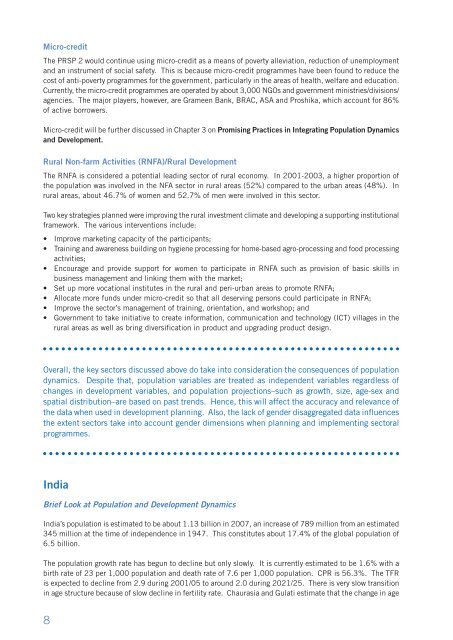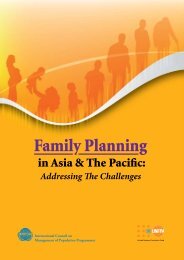Inter-lInkages between PoPulatIon DynamIcs anD DeveloPment In ...
Inter-lInkages between PoPulatIon DynamIcs anD DeveloPment In ...
Inter-lInkages between PoPulatIon DynamIcs anD DeveloPment In ...
Create successful ePaper yourself
Turn your PDF publications into a flip-book with our unique Google optimized e-Paper software.
Micro-creditThe PRSP 2 would continue using micro-credit as a means of poverty alleviation, reduction of unemploymentand an instrument of social safety. This is because micro-credit programmes have been found to reduce thecost of anti-poverty programmes for the government, particularly in the areas of health, welfare and education.Currently, the micro-credit programmes are operated by about 3,000 NGOs and government ministries/divisions/agencies. The major players, however, are Grameen Bank, BRAC, ASA and Proshika, which account for 86%of active borrowers.Micro-credit will be further discussed in Chapter 3 on Promising Practices in <strong>In</strong>tegrating Population Dynamicsand Development.Rural Non-farm Activities (RNFA)/Rural DevelopmentThe RNFA is considered a potential leading sector of rural economy. <strong>In</strong> 2001-2003, a higher proportion ofthe population was involved in the NFA sector in rural areas (52%) compared to the urban areas (48%). <strong>In</strong>rural areas, about 46.7% of women and 52.7% of men were involved in this sector.Two key strategies planned were improving the rural investment climate and developing a supporting institutionalframework. The various interventions include:• Improve marketing capacity of the participants;• Training and awareness building on hygiene processing for home-based agro-processing and food processingactivities;• Encourage and provide support for women to participate in RNFA such as provision of basic skills inbusiness management and linking them with the market;• Set up more vocational institutes in the rural and peri-urban areas to promote RNFA;• Allocate more funds under micro-credit so that all deserving persons could participate in RNFA;• Improve the sector’s management of training, orientation, and workshop; and• Government to take initiative to create information, communication and technology (ICT) villages in therural areas as well as bring diversification in product and upgrading product design.○ ○ ○ ○ ○ ○ ○ ○ ○ ○ ○ ○ ○ ○ ○ ○ ○ ○ ○ ○ ○ ○ ○ ○ ○ ○ ○ ○ ○ ○ ○ ○ ○ ○ ○ ○ ○ ○ ○ ○ ○ ○ ○ ○ ○ ○ ○ ○ ○ ○ ○ ○ ○ ○ ○ ○ ○ ○Overall, the key sectors discussed above do take into consideration the consequences of populationdynamics. Despite that, population variables are treated as independent variables regardless ofchanges in development variables, and population projections–such as growth, size, age-sex andspatial distribution–are based on past trends. Hence, this will affect the accuracy and relevance ofthe data when used in development planning. Also, the lack of gender disaggregated data influencesthe extent sectors take into account gender dimensions when planning and implementing sectoralprogrammes.○ ○ ○ ○ ○ ○ ○ ○ ○ ○ ○ ○ ○ ○ ○ ○ ○ ○ ○ ○ ○ ○ ○ ○ ○ ○ ○ ○ ○ ○ ○ ○ ○ ○ ○ ○ ○ ○ ○ ○ ○ ○ ○ ○ ○ ○ ○ ○ ○ ○ ○ ○ ○ ○ ○ ○ ○ ○<strong>In</strong>diaBrief Look at Population and Development Dynamics<strong>In</strong>dia’s population is estimated to be about 1.13 billion in 2007, an increase of 789 million from an estimated345 million at the time of independence in 1947. This constitutes about 17.4% of the global population of6.5 billion.The population growth rate has begun to decline but only slowly. It is currently estimated to be 1.6% with abirth rate of 23 per 1,000 population and death rate of 7.6 per 1,000 population. CPR is 56.3%. The TFRis expected to decline from 2.9 during 2001/05 to around 2.0 during 2021/25. There is very slow transitionin age structure because of slow decline in fertility rate. Chaurasia and Gulati estimate that the change in age8














